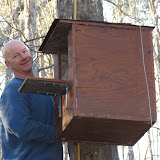 |
| Dehumidifier Install |
The 2nd air return I put in the MBR closet helped, but when we had a few warm days with dew points in the upper 60s, Maryann said she started noticing a musty smell in the corner of the bedroom. I set up the portable dehumidifier, and that took care of the issue. However, having to listen to it run and to dump the water one or more times a day, got old fast. I decided to bite the bullet and install a whole house dehumidifier.
Whole house dehumidifiers are no different than portable dehumidifiers except on how they are packaged. Whole house dehumidifiers have collars that allow them to be connected to ducts, and they require piping to a drain to handle the water removed from the air instead of using some type of catch bucket. Some whole house dehumidifiers require an external dehumidistat to control them. Others have an internal dehumidistat (again just like a portable dehumidifier). They all have an internal fan to move the air over the coils, and that fan works with the existing HVAC system fan.
Some of the larger whole house dehumidifiers also allow outside air to be drawn into them which is important in air tight homes. My house is not air tight, so being able to draw in outside air was not necessary. In fact, since the outdoor air in North Carolina can be very humid, it would add to the indoor humidity. My house being 'loose' is one of the reasons my indoor humidity is high to start with. I've not measured, but I'm sure I get several air exchanges per hour without even trying to add outdoor air on purpose. The number of air exchanges per hour will limit how low you can reduce your indoor humidity on humid days.
I searched and found several units based on the size of my existing AC unit (2 tons) and my home's square footage that would work. I decided on the TrueDRY DR65 by Honeywell. It can remove 65 pints (8+ gallons) of water per day and is Energy Star certified and removes 2.22 liters (4.7 pints) per kilowatt hour (KWH) of energy. It also had the advantage of a low height so that I could simply sit it on top of my existing air handler. That installation is simpler since it allows easy access to the return and supply plenums as well as the existing condensation drain. I had to run a new 120v circuit and install an outlet near the DR65. I choose to use the internal dehumidistat (I set it to 45% RH). I did install the backdraft damper which was recommended for the configuration I chose, Main Return to Main Supply, which puts the DR65 in parallel with the existing air handler. This configuration requires the air handler fan to run anytime the DR65 operates. This was simple to achieve using the sample wiring diagram provided which inserts the DR65 into the fan circuit. The demumidstat for the DR65 or the HVAC thermostat can turn on the system fan when needed. The backdraft damper is needed only when the system fan is on and the DR65 is not running.
The DR65 been in use for a couple weeks now, and it's keeping the indoor RH at 50% or less. On a couple of days, it ran continuously which cost less than $1.50 a day:
0.550kw (measured) x 24hrs x $0.105/kWh
On most days it cycles on and off as needed. The AC may run more often since the DR65 does add heat to the air as it is dehumidified and I didn't include that cost in my calculations. In theory, I could raise the indoor temperature a few degrees since dryer air feels cooler, but as of yet, I still have my thermostat set the same as before the DR65 (76F).
So as of now, I'm happy with my decision to purchase and install the DR65. It has a 5 year warranty. so I'm looking forward to many years of service from it. The only maintenance required is to replace the MERV 11 filter once a year.


